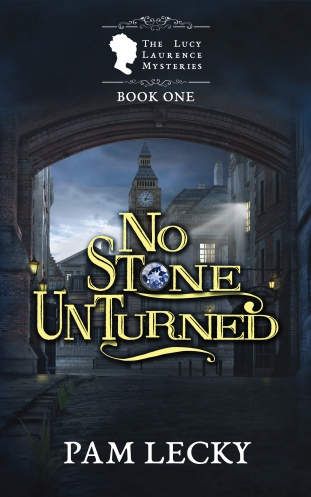For any lover of the Victorian era, London’s most famous cemeteries hold endless fascination. My favourites are Highgate and Kensal Green with their eerie Gothic and Neo-classical architecture. The Victorian obsession with death, the after-life and spiritualism, sparked the trend for highly decorated tombs and crypts. Heartbreaking inscriptions, lichen-encrusted headstones and mournful statuary lend a melancholy air to these places. It’s no wonder they feature so much in Gothic fiction. As I researched my novel, No Stone Unturned, I delved a little deeper into the history.
Both cemeteries were built in response to London’s population explosion in the early part of the 19th century which had resulted in graveyards being crammed in between shops and houses with little control over the number of corpses being interred. The smell these sites generated was described as terrible.
With public health at risk, Parliament passed a statute for seven new private cemeteries to be opened in the countryside around the city boundary. These included Highgate and Kensal Green.
Highgate Cemetery

Highgate is probably the most famous of all the Gothic cemeteries. In May 1839, it was dedicated to St James by the Lord Bishop of London. Of the seventeen acres, fifteen were consecrated for members of the Church of England and the remaining two acres were set aside for ‘Dissenters’ (everyone else). Elizabeth Jackson, aged thirty-six, was the first ever burial in Highgate in May 1839.
London’s wealthy invested heavily in the cemetery due to its amazing views over London (highest point 375 feet above sea level) and its unique architecture and landscaping.
Kensal Green Cemetery
“For there is good news yet to hear and fine things to be seen; Before we go to Paradise by way of Kensal Green.” G.K. Chesterton’s poem The Rolling English Road.
Kensal Green was opened by the Bishop of London on 24th January 1833 and was the first commercial cemetery in London. The first burial was the same month.
A competition for the design of the cemetery was held and the winning entry was for a Gothic style, however, the Chairman of the General Cemetery Company had other ideas. The final design was Neo-classical. As in Highgate, the burial grounds were divided up between the Church of England and the Dissenters.

An Unfortunate Death!
A pallbearer by the name of Henry Taylor met a tragic end in Kensal Green. While carrying a coffin, he missed his footing and stumbled. His fellow pallbearers let go of the coffin which fell on poor Henry, killing him instantly.
Here is the description from The Illustrated Police News, November 1872:
“KILLED BY COFFIN. Dr. Lancaster held an inquest Saturday evening at the University College Hospital, London, on the body Henry Taylor, aged 60. The evidence of E. J. Heading, undertaker’s foreman, and others showed that on the 19th inst. deceased, with others, was engaged at a funeral at Kensal-Green Cemetery. The Church service having been finished, the coffin and mourners proceeded in coaches towards the place of burial. The day being damp, the foreman directed the coaches with the mourners to proceed to the grave by the foot-way, and the hearse across the grass towards a grave-digger, who was motioning the nearest way. The coffin was moved from the hearse and being carried down a path only three feet six wide, by six bearers, when orders were given to turn, so that the coffin, which was what is known in the trade as a four pound leaden one, should head first. While the men were changing, it is supposed that deceased caught his foot against a side stone and stumbled; the other bearers, to save themselves, let the coffin go, and it fell with great force on to deceased, fracturing his jaws and ribs. The greatest confusion was created among the mourners who witnessed the accident, and the widow of the person about to be buried nearly went into hysterics. Further assistance having been procured the burial service was proceeded with, while deceased was conveyed to a surgery, and ultimately to the above mentioned hospital, where he expired on the 24th inst. The jury recommended that straps should be placed round coffins, which would tend to prevent such accidents. Verdict—accidental death. “
Sadly, although Henry lost his life in Kensal Green, it appears he was not buried there.
♦♦♦
In No Stone Unturned, my heroine Lucy Lawrence buries her husband Charlie in Kensal Green. A mysterious mourner at the graveside soon turns her life upside-down as Charlie’s dirty secrets spill from the grave …
No Stone Unturned is the first book in the Lucy Lawrence Mystery Series.
 A suspicious death, stolen gems and an unclaimed reward; who will be the victor in a deadly game of cat and mouse?
A suspicious death, stolen gems and an unclaimed reward; who will be the victor in a deadly game of cat and mouse?
London October 1886: Trapped in a troubled marriage, Lucy Lawrence is ripe for an adventure. But when she meets the enigmatic Phineas Stone, over the body of her husband in the mortuary, her world begins to fall apart.
When her late husband’s secrets spill from the grave and her life is threatened by the leader of London’s most notorious gang, Lucy must find the strength to rise to the challenge. But who can she trust and how is she to stay out of the murderous clutches of London’s most dangerous criminal?


added your book to my wish list!
LikeLiked by 1 person
Thanks Stacy x
LikeLike
Highgate Cemetery is famous. Author Audrey Niffengger’s book “Her Fearful Symmetry” has twin sisters living right near there.
LikeLiked by 1 person